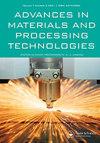Machining aerospace aluminium alloy with cryo-treated and untreated HSS cutting tools
IF 2.1
Q3 MATERIALS SCIENCE, MULTIDISCIPLINARY
Advances in Materials and Processing Technologies
Pub Date : 2023-10-24
DOI:10.1080/2374068x.2023.2273035
引用次数: 0
Abstract
ABSTRACTIn this study, effects of drilling parameters and cryogenic treatment, which were applied to the cutting tool (M35 HSS drill bit), on the burr width, surface roughness (Ra), chip formation and tool wear were investigated in drilling of AA2024-T3 aluminium alloy under dry drilling conditions. In this context, the drilling parameters determined based on the Taguchi experimental design were employed, and also, the analysis of variance (ANOVA) and regression analysis were performed. The spindle speed (1500, 3000 and 4500 rev/min), feed rate (100, 150 and 200 mm/min) and cutting tool (cryo-treated and untreated M35 HSS tools) were selected as machining parameters. In terms of average burr width, the performance of the cryo-treated (DC&T) HSS drill bit was 28.91% (for the highest value) and 46.96% (for the lowest value) better than that of the untreated (UT) HSS drill bit. According to Ra values, the performance of DC&T HSS drill bit was 13.29% (for highest value) and 12.01% (for lowest value) better than that of UT HSS drill bit. The flank wear (VB) of UT HSS drill bit was found to be approximately four times greater than the flank wear of DC&T HSS drill bit.KEYWORDS: AA2024cryogenic treatmentHSS drill bitsurface roughnesstool wear Disclosure statementNo potential conflict of interest was reported by the author.Author contributionsConceptualization, visualisation, investigation, review, editing, methodology, writing, etc. were performed by Mehmet Şükrü Adin.Additional informationFundingThe author declares that no funds, grants or other support were received during the preparation of this manuscript.用冷处理和未处理的高速钢刀具加工航空航天铝合金
摘要本研究研究了在干钻条件下,对AA2024-T3铝合金进行钻孔加工时,钻孔参数和刀具(M35 HSS钻头)进行深冷处理对毛刺宽度、表面粗糙度(Ra)、切屑形成和刀具磨损的影响。在此背景下,采用基于田口实验设计确定的钻井参数,并进行方差分析(ANOVA)和回归分析。选择主轴转速(1500、3000和4500转/min)、进给速度(100、150和200 mm/min)和刀具(冷处理和未处理的M35高速钢刀具)作为加工参数。在平均毛刺宽度方面,低温处理(DC&T)高速钢钻头的性能比未处理(UT)高速钢钻头的性能高28.91%(最大值)和46.96%(最小值)。根据Ra值,DC&T高速钢钻头的性能比UT高速钢钻头高13.29%(最大值),12.01%(最小值)。UT型高速钢钻头的齿面磨损(VB)约为DC&T型高速钢钻头齿面磨损的4倍。关键词:aa2024低温处理;thss钻头表面粗糙度;钻具磨损;作者贡献概念化、可视化、调查、审查、编辑、方法、写作等由Mehmet Şükrü Adin完成。作者声明在撰写本文期间没有收到任何资金、资助或其他支持。
本文章由计算机程序翻译,如有差异,请以英文原文为准。
求助全文
约1分钟内获得全文
求助全文
来源期刊

Advances in Materials and Processing Technologies
MATERIALS SCIENCE, MULTIDISCIPLINARY-
CiteScore
3.90
自引率
27.30%
发文量
222
 求助内容:
求助内容: 应助结果提醒方式:
应助结果提醒方式:


